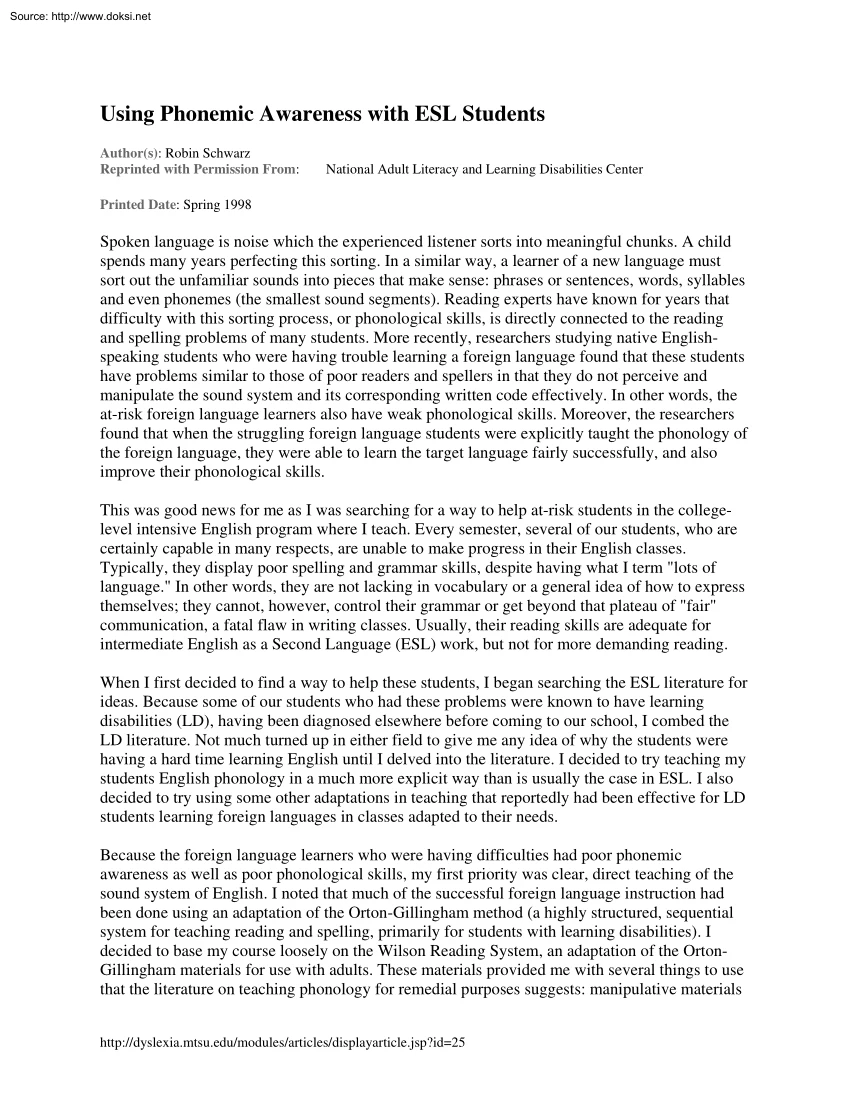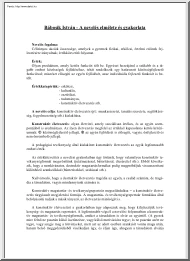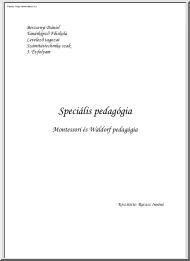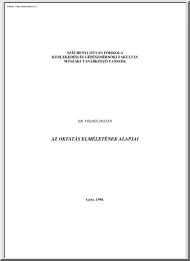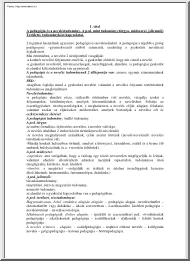Datasheet
Year, pagecount:2011, 3 page(s)
Language:English
Downloads:2
Uploaded:May 25, 2020
Size:468 KB
Institution:
-
Comments:
National Adult Literacy and Learning Disabilities Center
Attachment:-
Download in PDF:Please log in!
Comments
No comments yet. You can be the first!Most popular documents in this category
Content extract
Source: http://www.doksinet Using Phonemic Awareness with ESL Students Author(s): Robin Schwarz Reprinted with Permission From: National Adult Literacy and Learning Disabilities Center Printed Date: Spring 1998 Spoken language is noise which the experienced listener sorts into meaningful chunks. A child spends many years perfecting this sorting. In a similar way, a learner of a new language must sort out the unfamiliar sounds into pieces that make sense: phrases or sentences, words, syllables and even phonemes (the smallest sound segments). Reading experts have known for years that difficulty with this sorting process, or phonological skills, is directly connected to the reading and spelling problems of many students. More recently, researchers studying native Englishspeaking students who were having trouble learning a foreign language found that these students have problems similar to those of poor readers and spellers in that they do not perceive and manipulate the sound system
and its corresponding written code effectively. In other words, the at-risk foreign language learners also have weak phonological skills. Moreover, the researchers found that when the struggling foreign language students were explicitly taught the phonology of the foreign language, they were able to learn the target language fairly successfully, and also improve their phonological skills. This was good news for me as I was searching for a way to help at-risk students in the collegelevel intensive English program where I teach. Every semester, several of our students, who are certainly capable in many respects, are unable to make progress in their English classes. Typically, they display poor spelling and grammar skills, despite having what I term "lots of language." In other words, they are not lacking in vocabulary or a general idea of how to express themselves; they cannot, however, control their grammar or get beyond that plateau of "fair" communication, a fatal
flaw in writing classes. Usually, their reading skills are adequate for intermediate English as a Second Language (ESL) work, but not for more demanding reading. When I first decided to find a way to help these students, I began searching the ESL literature for ideas. Because some of our students who had these problems were known to have learning disabilities (LD), having been diagnosed elsewhere before coming to our school, I combed the LD literature. Not much turned up in either field to give me any idea of why the students were having a hard time learning English until I delved into the literature. I decided to try teaching my students English phonology in a much more explicit way than is usually the case in ESL. I also decided to try using some other adaptations in teaching that reportedly had been effective for LD students learning foreign languages in classes adapted to their needs. Because the foreign language learners who were having difficulties had poor phonemic awareness as
well as poor phonological skills, my first priority was clear, direct teaching of the sound system of English. I noted that much of the successful foreign language instruction had been done using an adaptation of the Orton-Gillingham method (a highly structured, sequential system for teaching reading and spelling, primarily for students with learning disabilities). I decided to base my course loosely on the Wilson Reading System, an adaptation of the OrtonGillingham materials for use with adults. These materials provided me with several things to use that the literature on teaching phonology for remedial purposes suggests: manipulative materials http://dyslexia.mtsuedu/modules/articles/displayarticlejsp?id=25 Source: http://www.doksinet to make the instruction multisensory , plenty of lists of controlled words for lots and lots of repetition, lists of nonsense words and syllables to practice decoding and encoding, and sentences and stories for more extended practice. The major
drawback of these materials was that they were designed for native English-speaking students and so were highly idiomatic and full of challenging vocabulary. I felt, however, the practice that the lists and stories provided was more important than the vocabulary challenge; and, in fact, the vocabulary was not a problem. Another lesson learned from the foreign language research was that the sounds should be taught one at a time in a clear sequence. I chose to start by teaching the short vowels in alphabetical order to match some other ESL materials I had, and I selected the appropriate parts of the Wilson System for drills or activities. Typically, I would present a sound with pictures and repetition, then have students listen to and repeat minimal pairs, such as tan/tin, bad/bid; slap/slip. This made them concentrate on the medial vowel sound. The final test in this part was for the students to change the vowel in the other sound when I said the first sound. If I said "tan,"
the students, one at a time, had to respond with "tin." Phonemic awareness, one of the skills found lacking in poor readers and poor language learners, was much enhanced by doing this because the students had to isolate individual phonemes to be able to change the sound. Once they could do this orally, I would dictate lists in the same order, and then they would read them. After that, they read lists of real words, followed by lists of nonsense words. Finally, the students wrote those words from dictation so they could hear, spell, and read the short vowel patterns accurately. Each time I presented a new vowel, I started by reviewing the ones learned already, and on intervening days, students practiced the vowels with sorting activities, games, and dictations. They also identified vowel sounds and patterns in their reading and writing assignments, an important step given that at-risk students often do not generalize information or skills easily and, therefore, require
directed practice. The process requires lots and lots of repetition. Students with difficulty in the language area require much more time to process information and much more review and practice than average learners. We continued on to long vowels, and the process became faster because the students had begun to discriminate sounds more accurately and knew what to expect in the activities and practices. Once they were confident with long and short vowels, we moved into work with syllables, first listening for the number, then identifying closed syllables (short vowel followed by a consonant) and open syllables (long vowel), and finally reading and writing words by syllable. At first, the students, who were of college age or older and many of whom were graduate students, were skeptical of these lessons. When they began to see the resuits, however, they became enthusiastic and made sure to request handouts missed when they were absent. Those who knew they had made progress, but had not
yet mastered the skills, asked if there were some way to have more lessons in a lab or some other classes. Although there is not much research on teaching phonology to ESL students who are at risk, my students experiences clearly demonstrated the benefits of this instruction. Of course, their spelling improved dramatically, and a few needed more sustained review and practice to maintain their gains. A more pervasive benefit was that they could perceive individual words in http://dyslexia.mtsuedu/modules/articles/displayarticlejsp?id=25 Source: http://www.doksinet spoken sentences far more accurately than before. This resulted in significantly more accurate dictations and, so the students reported, a noticeably improved ability to follow conversations and proceedings in other classes. In addition to my observations of the students increased confidence in many domains, their other teachers reported similar improvements. Another important benefit of the phonology instruction, though
less directly documented outside of our class, was that the students decoding skills increased significantly. They amazed themselves by reading multisyllabic words with ease. Finally, overall, these students were able to do much better in their classes than students with similar problems in our program who had not had such intervention. It is my hope that, research will bear out these benefits. In the meantime, our university is benefitting from these instruction methods by retaining students who otherwise might have dropped out of classes and by strengthening the foreign language acquisition skills of at-risk native English-speaking students. Suggestions for Further Reading Frost, J., & Emery, M J (1995) Academic interventions for children with dyslexia who have phonological core deficits (ERIC Digest E 539). Reston, VA: ERIC Clearinghouse on Disabled and Gifted Education. (ERIC Document Reproduction Service No ED 385 095) Granschow, L., & Sparks, R ( 1995) Effects of direct
instruction in Spanish phonology on the native language skills and foreign language aptitude of at-risk foreign language learners. Journal of Learning Disabilities, 28, 117-120. Gerber, A. (1993) Language-related learning disabilities Baltimore: Paul H Brookes Hill, B., Downey, D, Sheppard, M, & Williamson, V (1995) Accommodating the needs of students with severe language learning difficulties in modified foreign language classes. In G Grouse (Ed.), Broadening frontiers of language education (pp 45-56) Lincolnwood, IL: National Textbook Co. Schwarz, R., & Burt, M (1995) ESL instruction for learning disabled adults Washington, DC: National Clearing house for ESL Literacy Education. Sparks, R., Granschow, L, Kenneweg, S, & Miller, K (1991) Use of an Orton-Gillingham approach to teach a foreign language to dyslexic/learning disabled students: Explicit teaching of phonology in a second language. Annals of Dyslexia, 41, 96-118 Wilson, B. (1993) Wilson Reading System Milbury, MA:
Wilson Language Training http://dyslexia.mtsuedu/modules/articles/displayarticlejsp?id=25
and its corresponding written code effectively. In other words, the at-risk foreign language learners also have weak phonological skills. Moreover, the researchers found that when the struggling foreign language students were explicitly taught the phonology of the foreign language, they were able to learn the target language fairly successfully, and also improve their phonological skills. This was good news for me as I was searching for a way to help at-risk students in the collegelevel intensive English program where I teach. Every semester, several of our students, who are certainly capable in many respects, are unable to make progress in their English classes. Typically, they display poor spelling and grammar skills, despite having what I term "lots of language." In other words, they are not lacking in vocabulary or a general idea of how to express themselves; they cannot, however, control their grammar or get beyond that plateau of "fair" communication, a fatal
flaw in writing classes. Usually, their reading skills are adequate for intermediate English as a Second Language (ESL) work, but not for more demanding reading. When I first decided to find a way to help these students, I began searching the ESL literature for ideas. Because some of our students who had these problems were known to have learning disabilities (LD), having been diagnosed elsewhere before coming to our school, I combed the LD literature. Not much turned up in either field to give me any idea of why the students were having a hard time learning English until I delved into the literature. I decided to try teaching my students English phonology in a much more explicit way than is usually the case in ESL. I also decided to try using some other adaptations in teaching that reportedly had been effective for LD students learning foreign languages in classes adapted to their needs. Because the foreign language learners who were having difficulties had poor phonemic awareness as
well as poor phonological skills, my first priority was clear, direct teaching of the sound system of English. I noted that much of the successful foreign language instruction had been done using an adaptation of the Orton-Gillingham method (a highly structured, sequential system for teaching reading and spelling, primarily for students with learning disabilities). I decided to base my course loosely on the Wilson Reading System, an adaptation of the OrtonGillingham materials for use with adults. These materials provided me with several things to use that the literature on teaching phonology for remedial purposes suggests: manipulative materials http://dyslexia.mtsuedu/modules/articles/displayarticlejsp?id=25 Source: http://www.doksinet to make the instruction multisensory , plenty of lists of controlled words for lots and lots of repetition, lists of nonsense words and syllables to practice decoding and encoding, and sentences and stories for more extended practice. The major
drawback of these materials was that they were designed for native English-speaking students and so were highly idiomatic and full of challenging vocabulary. I felt, however, the practice that the lists and stories provided was more important than the vocabulary challenge; and, in fact, the vocabulary was not a problem. Another lesson learned from the foreign language research was that the sounds should be taught one at a time in a clear sequence. I chose to start by teaching the short vowels in alphabetical order to match some other ESL materials I had, and I selected the appropriate parts of the Wilson System for drills or activities. Typically, I would present a sound with pictures and repetition, then have students listen to and repeat minimal pairs, such as tan/tin, bad/bid; slap/slip. This made them concentrate on the medial vowel sound. The final test in this part was for the students to change the vowel in the other sound when I said the first sound. If I said "tan,"
the students, one at a time, had to respond with "tin." Phonemic awareness, one of the skills found lacking in poor readers and poor language learners, was much enhanced by doing this because the students had to isolate individual phonemes to be able to change the sound. Once they could do this orally, I would dictate lists in the same order, and then they would read them. After that, they read lists of real words, followed by lists of nonsense words. Finally, the students wrote those words from dictation so they could hear, spell, and read the short vowel patterns accurately. Each time I presented a new vowel, I started by reviewing the ones learned already, and on intervening days, students practiced the vowels with sorting activities, games, and dictations. They also identified vowel sounds and patterns in their reading and writing assignments, an important step given that at-risk students often do not generalize information or skills easily and, therefore, require
directed practice. The process requires lots and lots of repetition. Students with difficulty in the language area require much more time to process information and much more review and practice than average learners. We continued on to long vowels, and the process became faster because the students had begun to discriminate sounds more accurately and knew what to expect in the activities and practices. Once they were confident with long and short vowels, we moved into work with syllables, first listening for the number, then identifying closed syllables (short vowel followed by a consonant) and open syllables (long vowel), and finally reading and writing words by syllable. At first, the students, who were of college age or older and many of whom were graduate students, were skeptical of these lessons. When they began to see the resuits, however, they became enthusiastic and made sure to request handouts missed when they were absent. Those who knew they had made progress, but had not
yet mastered the skills, asked if there were some way to have more lessons in a lab or some other classes. Although there is not much research on teaching phonology to ESL students who are at risk, my students experiences clearly demonstrated the benefits of this instruction. Of course, their spelling improved dramatically, and a few needed more sustained review and practice to maintain their gains. A more pervasive benefit was that they could perceive individual words in http://dyslexia.mtsuedu/modules/articles/displayarticlejsp?id=25 Source: http://www.doksinet spoken sentences far more accurately than before. This resulted in significantly more accurate dictations and, so the students reported, a noticeably improved ability to follow conversations and proceedings in other classes. In addition to my observations of the students increased confidence in many domains, their other teachers reported similar improvements. Another important benefit of the phonology instruction, though
less directly documented outside of our class, was that the students decoding skills increased significantly. They amazed themselves by reading multisyllabic words with ease. Finally, overall, these students were able to do much better in their classes than students with similar problems in our program who had not had such intervention. It is my hope that, research will bear out these benefits. In the meantime, our university is benefitting from these instruction methods by retaining students who otherwise might have dropped out of classes and by strengthening the foreign language acquisition skills of at-risk native English-speaking students. Suggestions for Further Reading Frost, J., & Emery, M J (1995) Academic interventions for children with dyslexia who have phonological core deficits (ERIC Digest E 539). Reston, VA: ERIC Clearinghouse on Disabled and Gifted Education. (ERIC Document Reproduction Service No ED 385 095) Granschow, L., & Sparks, R ( 1995) Effects of direct
instruction in Spanish phonology on the native language skills and foreign language aptitude of at-risk foreign language learners. Journal of Learning Disabilities, 28, 117-120. Gerber, A. (1993) Language-related learning disabilities Baltimore: Paul H Brookes Hill, B., Downey, D, Sheppard, M, & Williamson, V (1995) Accommodating the needs of students with severe language learning difficulties in modified foreign language classes. In G Grouse (Ed.), Broadening frontiers of language education (pp 45-56) Lincolnwood, IL: National Textbook Co. Schwarz, R., & Burt, M (1995) ESL instruction for learning disabled adults Washington, DC: National Clearing house for ESL Literacy Education. Sparks, R., Granschow, L, Kenneweg, S, & Miller, K (1991) Use of an Orton-Gillingham approach to teach a foreign language to dyslexic/learning disabled students: Explicit teaching of phonology in a second language. Annals of Dyslexia, 41, 96-118 Wilson, B. (1993) Wilson Reading System Milbury, MA:
Wilson Language Training http://dyslexia.mtsuedu/modules/articles/displayarticlejsp?id=25
